 |
"RUSSIAN STYLE"
(A DECLINE IN QUALITY) |
|
May 2011
was "Russian month" here. We were contacted by several
collectors from Russia for swapping and trading and this led to an
inspection of our collection of Russian decks. We were surprised to hear
that Russian standard patterns were very sought in Russia at this
moment, especially the older and Russian made versions. Almost all these
collectors complained that the Chinese made cards with Russian patterns
were taking over the present market there and that the quality of the
cards was poor.
In our collection of Russian decks there were a number of standard
patterns too and we too found that the quality of some patterns showed a
strong decline, although our decks were made in Russia and not in
China. But here it was not as much the quality of the carton, but the
quality of printing, that made the difference. And one pattern stuck out
in that respect.
Of course we went to the WWWPCM website to see if there was some
information there about the different versions of this pattern and their
dates. But we found that we had versions in our collection, that were
not mentioned there. So we consulted Alexander (Sasha) Sukhorukov, who
operates this site, and he was kind enough to answer almost all our questions. |
|
The first
misunderstanding was, that somehow in the Netherlands this pattern was
referred to as "Bojaren", while the official name is
"Russian Style". It was mentioned as such in pricelists from
the 1920's and 30's. With Sasha's information at hand we've taken a
closer look at this pattern. We'll start with the first version of this
deck, which is shown here on this page...... |

The pattern will
probably look familiar to a lot of collectors, with the richly embellished
dresses and special head wear. The story behind these designs is, that they
refer to a costumed ball that the Romanoff family held on February 13, 1903 and
where all the attendees were dressed in 16th and 17th century Russian costumes.
In 1910 a special Celebration Committee was formed to organize special
activities to celebrate the 300th anniversary of the House of Romanoff in 1913.
One of the ideas was to create a deck, that would show costumes from that famous
costumed ball.
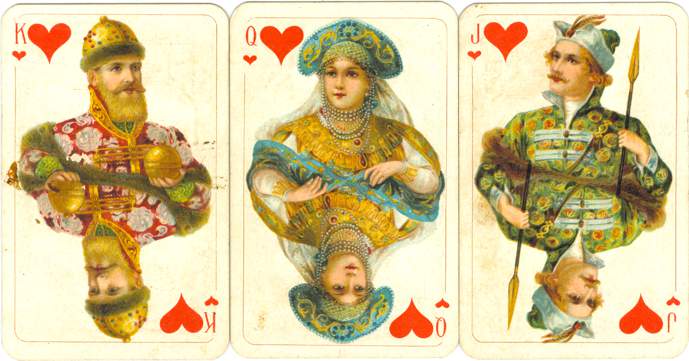
The design of the
courts is attributed to the Dondorf company from Frankfurt, Germany. And when
you look at the fine chromolithographic printing, it's not unlikely that the
stones for the courts and aces were produced by Dondorf, as this firm was in
those days renowned for its quality in chromolithographic printing and already
had a good relationship with the Alexander Manufacture's Card Fabrique from St.
Petersburg. In that period the name of the state monopoly printing firm, which
we later got to know as the Colour Printing Plant. Sasha has an interesting page
with all the different names in different periods of this company: click
to see!
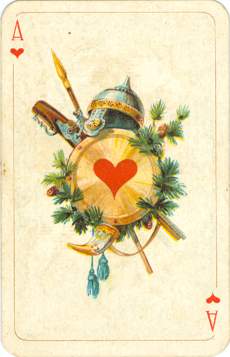


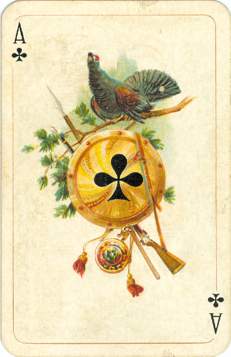
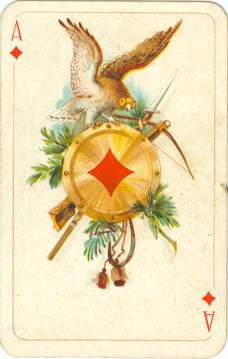
The aces show
shields with all kind of weaponry. Although the aces of Clubs and Diamonds show
birds, we don't think that it's a hint towards a hunting scene, as the shown
weapons are not really fit for the hunt. Who will use a bayonet on a rifle for
hunting or a sword? The back design is attributed to the first edition. It's not
a known back design of the Dondorf company, but it could have been specially
designed for this deck. It could also be a back design by the CPP. Judging by
the complete design, we are drawn towards that last option.
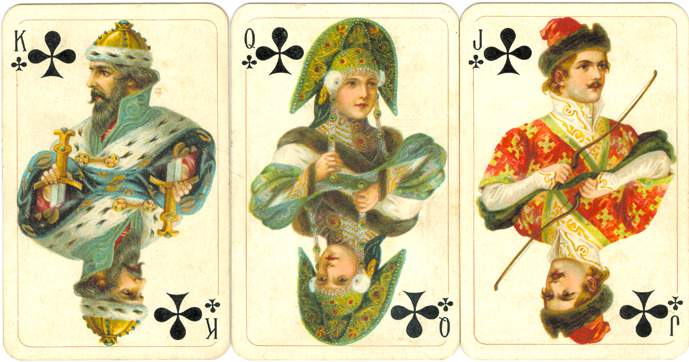
For a further comparison between the different later
editions we have chosen the Jack of Clubs.
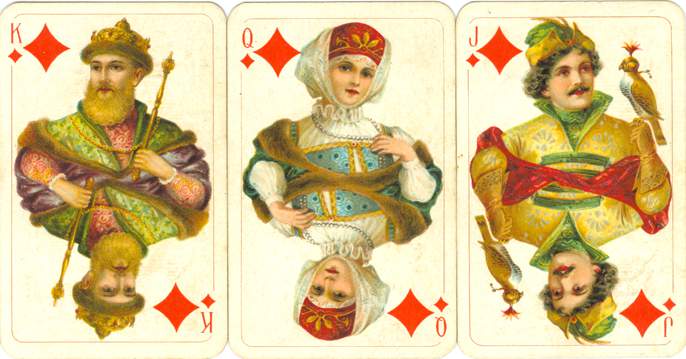
There remains one
unresolved question and it concerns the use of English indices for this deck.
With a German co-producer and a Russian celebration purpose, English indices are
the least expected. Speculations may lead to a great variety of probable causes,
but we believe that this edition probably served as a souvenir deck for foreign
visitors and that there must have been an edition with Russian indices as well.
Now we will just have to wait until a deck turns up that will substantiate this
assumption.
On the next pages
later versions of this pattern will be shown.
-1- -2-
-3- -4- -5-
VARIATIONS









